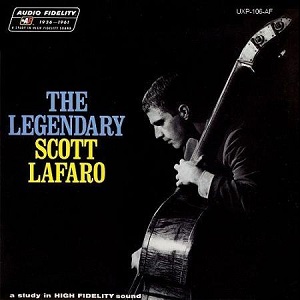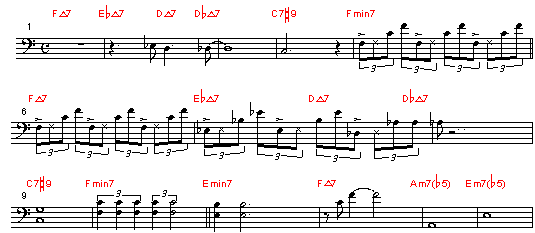 IMPORTANT NOTE: This article on Scott LaFaro is authored by Jeff Addicott (not Warren Sirota as the software insists on listing)
IMPORTANT NOTE: This article on Scott LaFaro is authored by Jeff Addicott (not Warren Sirota as the software insists on listing)
Once, during my final semester at music school, I was chatting with one of the instructors, and he told me how he was constantly disappointed by the fact that not one of his students had done anywhere near enough listening to records. He went on a rant about how some people couldn’t even tell the difference between Jack DiJohnette and Peter Erskine.
Then I made an awkward confession: I don’t know who Peter Erskine is.
The instructor dropped his jaw, then he turned around and walked off, shaking his head with disgust.
Ouch. (What can I say? I wasn’t very hip to Weather Report yet. I’m still not, actually; shame on me. But at least I know who Peter Erskine is, now.)
After the rush of finals and recitals was over, I made a very distinct point of getting my hands on as many records as I could… and listening to them a lot! Thus, my formal music education had ended and my real music education began.
On my bass teacher’s strong advice, one of the CDs I picked up was The Bill Evans Trio: Sunday at the Village Vanguard. (Riverside OJCCD-140) I popped it in my CD player and I’ve never been the same since!
I was immediately taken by the unique bass style of Scott LaFaro. His approach was so revolutionary, so free and yet so graceful. The bass was no longer merely part of the floor for the lead player to dance upon. The bass was out there dancing alongside the piano! Check out the following example from the beginning of Gloria’s Step (a fantastic song written by: his truly), take 2:

Click here for a MIDI file of this example
Click here for a MIDI file of this example complete with piano melody
Notice how Scott constantly changes his line on a whim, from syncopated shots to whole notes to rapid-fire triplet fills to playing 2’s. His line is highly interactive with the piano part. He advances to fill in spaces left open by the piano, then retreats to allow the piano to resume the lead melody. Even during the piano solo, Scott is constantly stirring things up in the background, never quite settling down to the traditional 4 quarter notes to a bar. Amazingly, he manages to do this without disrupting the other players or distracting the listener from Bill Evans’ impeccable piano solo. (Speaking of solos, Scott was definitely no slouch in that department! His solos throughout the record are well worth a good listen.)
One of the fantastic things about CD reissues is the bonus tracks they throw in. On this particular reissue, they include alternate takes on no less than 4 different tunes! This can provide you with a lot of insight as to how this incarnation of the Bill Evans Trio used to function. Check out the beginning of Gloria’s Step, take 3:

Click here to hear a MIDI file of this example
Click here to hear a MIDI file of this example complete with piano melody
How about bars 5-9!! My brain hurts.
Compare take 3 with take 2, and notice how different the two are! The fills are all different, and they come in different places. Even the syncopated shots that make up part of the song structure are varied. Bear in mind that these changes did not evolve over a period of months. Takes 2 and 3 occurred on the same day! Scott really kept those new ideas coming.
For me, comparing these two takes gets to the very essence of how Jazz music needs to be played. Nothing should ever be bolted down; you should always be incorporating new ideas and responding to the energy of the moment.
I learned as much from transcribing these examples as I did from 2 years of music school. I can hear its influence on me every time I play. So can other musicians. And what we have printed here is just the tip of the iceberg. I’d give you the music for the rest of the 2 tracks… but why should I have all the fun?
Whenever any performer goes out on a limb, he or she needs to be able to trust the other performers to back him/her up. The Bill Evans Trio you hear on this recording had been working and evolving together for two years, and they came to epitomize the notion of trust with their unique style of interplay. (Tragically, this was the last time they played together before Scott LaFaro was killed in a car crash.)
If you haven’t had the opportunity to play jazz with this type of freedom and interaction, I hope you do soon. There’s nothing quite like it.
A word of caution: this approach to bass line construction isn’t appropriate for every occasion. Your fellow performers have to be open and receptive to what you are doing, and they have to be capable of responding in kind. And of course, the reverse applies, as well! You should probably NOT attempt that polyrhythmic flurry of notes from take 3 with people you haven’t played with much. Especially not on a gig!
Before you start LaFaroizing your bass lines on every jazz tune, you always need to consider the context of the musical situation. Some music styles are not compatible with overtly vigorous bass experimentation. Insensitive overplaying is an excellent way to put yourself on the bottom of everyone’s list and stop gigging fast. (Don’t make it happen to you!)
Interestingly, I find that copping some of the Scott LaFaro approach has actually helped to prepare me for situations when I need to play more simply. I think that one plays quarter notes better when one chooses to, instead of simply doing so for lack of any other ideas. Nowadays, I keep my part real basic when I decide that it’s the best choice (as opposed to the only choice).
Of course, anyone who has seriously listened to Ray Brown or Ron Carter knows that quarter note walking bass is a lifelong fine art unto itself. And if you listen to a lot of ‘40s and ‘50s New Orleans R&B, it will actually make you crave the playing of gloriously, fabulously simple bass parts.
But that’s another column…
Jeff Addicott
Jeff Addicott is one of Southern Oregon’s busiest freelance musicians. He studied popular music performance at Mount Royal College in Calgary, Alberta before moving to Oregon in 1996. He currently performs with a wide variety of artists, including: Sage Meadows, The Muskadine Blues Quartet, Modern Prometheus, Salsa Brava, Gayle Wilson, The Djangoholics, The Blue Notes, Q&A, The Wild Goose Chase Trio, Paul Turnipseed, Danielle Kelly and The Sultans.
In addition to his busy music schedule, Jeff is also a full-time glassblower.
